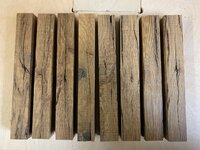I have been asked to make pens from a piece of white oak salvaged from a 150+ year old barn. The wood is very hard and very dry, not punky. I cut the piece of wood into 8 pen blanks, but as you can see in the attached picture, each piece has numerous checks and cracks that need to be stabilized before turning.

What is the best method to stabilize them? From what I understand, stabilization under a vacuum with Cactus Juice is more for use in punky wood and not as a void filler. So I think I'm looking at a pressure-based process using epoxy or some other type of filler. Is that correct? I am new to the whole stabilization process and want to make sure I don't ruin the blanks, which have sentimental value to the requester. Suggestions?

What is the best method to stabilize them? From what I understand, stabilization under a vacuum with Cactus Juice is more for use in punky wood and not as a void filler. So I think I'm looking at a pressure-based process using epoxy or some other type of filler. Is that correct? I am new to the whole stabilization process and want to make sure I don't ruin the blanks, which have sentimental value to the requester. Suggestions?
